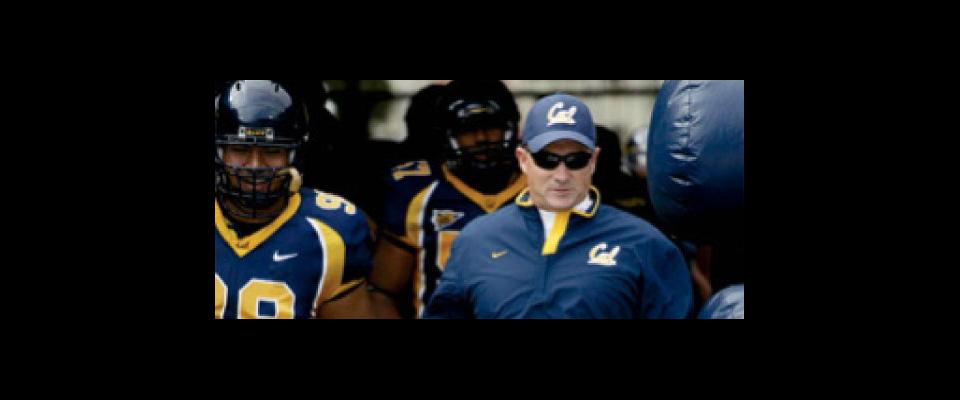A portrait of the artist as an aging NFL lineman
On mornings he can’t sleep, Ed White will brew up a pot of coffee, wander out to his studio, and paint through sunrise. Insomnia or no insomnia, he’s out there at least three days a week. He compares painting to digging. “You dig and you dig and you get to that point where you hit hardpan. And you just gotta keep digging.” On this particular morning, the “excavation” involved an old pickup truck Ed once saw abandoned near the beach on Kauai, its bed converted to a planter and overgrown with flowers. As he worked, the stereo played. Curtis Mayfield sang People Get Ready at top volume.
Ed works in a variety of media: acrylic, watercolor, pen and ink, even sculpture, and his subjects range from abstracts to nudes, landscapes to … football. He knows a lot about football. A former All-Pro offensive lineman, first with the Minnesota Vikings, then with the San Diego Chargers, he played 17 years in the NFL.
The studio is just a few steps from the main house, where a sign on the door reads: An Old Bear Lives Here With His Honey. Ed’s honey is Joan (pronounced Jo-ann), his wife of 42 years. The two were sweethearts at Indio High School and she followed him to Berkeley, enrolling at Cal as Joan Boyer in 1966. When they married in Ed’s junior year, she forfeited the maiden name and Ed was forced to forfeit the football scholarship. Those were different times.
As a second-round draft pick in 1969, Ed’s rookie contract with the Vikings was worth just $19,000—not bad for the son of a construction laborer, but chump change by today’s standards. To complement his salary, he put his landscape architecture degree to work designing playgrounds in the off-seasons for the St. Paul Housing and Redevelopment Authority. By the time he retired from the Chargers in 1986, Ed was pulling down more than $200,000 a year. Today, the best offensive linemen in the NFL can make upwards of $9 million per season.
How good was Ed? Good enough that he should be in the NFL Hall of Fame, according to many of his peers, including his former Chargers quarterback Dan Fouts, himself a Hall of Famer. “The accomplishments are all there,” Fouts told me. “The guy was in four Super Bowls, the first to be All-Pro in both conferences. You talk to his contemporaries, they’ll tell you the same thing. But it’s very difficult for offensive lineman to get inducted. The only stats they keep for those guys is starts and games played. And Big Ed is tops there, too—241 games, a record at that time.”
Jim Hanifan ’55, who played at Cal under the legendary Pappy Waldorf, was offensive line coach when Ed played for the Chargers. Hanifan is effusive on the subject of Ed White: “Ed White is a beautiful person.” “There is not a single phony thing about Ed White.” “If everyone could be like Ed White, my God, we’d have a wonderful world!” At the same time, he assured me, Ed White in pads was one muy mal hombre, not to mention a hell of an athlete—extremely quick for a big man and with great agility and recoverability. “You always kind of felt sorry for the guy across the line from him, ’cause you knew he was going to kick the living hell out of him.”
Out in his studio, Ed showed me his “violence in football” series. There were paintings of men impaled by helmets, players exploding on impact, limbs flying in all directions, guys stretched out on the turf, their spirits rising heavenward. Ed took one down from the wall. “I call this one Butt Kiss“—a reference to Dick Butkus, former middle linebacker of the Chicago Bears, once among the most feared men in football. “I hated that guy. I used to knock his ass down and he’d go, ‘You pussy!’ Then I’d come back on the next play and knock his ass down again.”
In another corner of the studio sat a sculpture Ed had been working on, a pair of hands that seemed to converge around an unseen object—a neck, perhaps. Or a football. I said it looked like the hands of a center preparing for a snap to the kicker.
“Huh, that’s interesting. No, the hands are meant to be in the shape of a heart.”
Ironically, Ed never thought of himself as an offensive lineman. Offensive players tend to think like coaches, in X’s and O’s and set plays. Ed operates more on instinct.
At Cal he was a consensus All-American at nose guard, the standout player on a standout defensive squad known in the sporting press as the Bear Minimum Defense. The 1969 Blue & Gold devoted a page to Ed. In a pair of black-and-white photos, he rises off the line like a breaching white shark to devour the quarterback. They called him Goose then, because he “ran like one,” his cleats barely clearing the grass tops. He considers it one of the secrets to his success. “You can only transfer power with your feet on the ground,” he told me. “The Goose always had his feet on the ground.”
The Vikings had all the defensive horsepower they needed (remember the Purple People Eaters?), and the Goose was switched to offense against his wishes. He never switched back. And though he remained a tackler at heart, Ed said he “loved being a part of this group called offensive linemen.”
“It’s like a fraternity, in part because it’s the last holding ground. You’re not fast enough, you’re not tall enough, you’re not this, you’re not that? OK, offensive line.” In some ways, he continued, it’s the easiest position to play. “And yet, it might also be the most difficult, because the best, the cream, is over there on defense. They’re faster, quicker, stronger, taller, so your brain has to be the equalizer.”
In the pros, they called him “Big Ed.” A natural 300-pounder in an era before 300-pound linemen were NFL stock-in-trade, Ed is big in the way models are beautiful; it’s not any one thing about him, it’s everything—his neck, his ankles, his fingers. The first time we shook hands, my arm felt like the handle on a baby’s rattle.
I’d arrived in Julian on a warm night in October, driving to this mountain hamlet an hour east of San Diego, where Joan and Ed raised their three children—sons Tim and Randall, and daughter Amy. In an email, Ed had instructed me to call him from the road so he could meet me at the turnoff to his place. “I’ll be the large man under the larger tree.” Sure enough, there he stood, a Shrek-like figure in shorts, sandals, and a XXXL T-shirt, swinging his flashlight like a railroad signalman.
I pulled over and lowered the passenger-side window.
“Pat? Ed!” My hand disappeared in his grip.
As he crammed his bulk into the rental car, Ed told me he’d been growing a little nervous out there all alone in the dark, thinking about mountain lions. I shot a sidelong glance at my passenger. In 1975, Ed was crowned NFL arm-wrestling champ. I’d heard he could tear phone books in half with his bare hands. If any man could whip his weight in wildcats, I thought, it was the guy riding shotgun.
The impulse for my visit had less to do with his strengths, however, than what I feared might be his vulnerabilities. Specifically, I had concerns about Ed’s head. The top sports story of the year was football’s so-called concussion crisis. With each passing week, it seemed, fresh horror stories were appearing in the press about players whose lives had descended into a nightmare of depression and dementia, their autopsies revealing severe brain damage. The medical name for the condition is chronic traumatic encephalopathy, and it has so far proven particularly prevalent in NFL linemen. Statistically speaking, the more years a player was in the game, the higher the risk.
As Ed prepared lunch the next day—pasta with vegetables from the garden—I grilled him about his own experience with concussions. Players are notorious for brushing off the “dings” of the game, and Ed isn’t any different. He could remember getting his bell rung, sure, but nothing out of the ordinary.
The worst incidents, in fact, had happened off the field, like the time he went over the handlebars of his mountain bike, or the time he ran into a wall of the racquetball court and knocked himself cold. As the pasta sauce simmered, however, a few on-field memories did eventually bubble to the surface. There was that one time on special teams in Atlanta, “running the wedge” with Ron Yary. Ed stood up after the play and the entire stadium was spinning around. The whole next series, it just kept spinning.
After his first concussion with the Chargers, he remembered being left on the examining table while the doctors studied his x-rays. They were gone so long, Ed finally wandered back to find them marveling at his films. They asked if he remembered when he’d broken his neck. “I didn’t know I’d broken my neck!” Ed said, sounding more amused than alarmed—at least, in the retelling. “My neck is still screwed up, too, but it works.”
While concussions may have been the least of it for Ed, he neither dismisses the reality of football-related head injuries, nor minimizes the plight of ex-players who have been left disabled. To the contrary, Ed is on the board of a group called Dignity After Football, which advocates for players who gave mind, body, and soul to the game.
When Joan was present for our conversations, she would occasionally finish Ed’s sentences or correct him on dates and names he’d gotten wrong. I asked her if it had always been this way. Ed headed me off: “Oh, that goes back way before the brain damage!” Joan concurred. “Ed’s never been real good with details.”
OK, but even if he wasn’t cognitively impaired, I still wondered: Was she concerned about the whole concussion issue? As a football fan, did she take the risk seriously? “I am. I do,” she answered. “After all, our daughter was taken by a head injury.”
Like her father, Amy White was a standout athlete. Ed and Joan’s youngest child, a star of the Julian High School basketball team, had accepted a partial scholarship from Cal Poly, where she planned to study architecture. Shortly after high school graduation, she was out with friends when she had them stop at a florist so she could buy flowers for her parents’ anniversary. Afterward, they decided to drive across the parking lot to grab a bite. Rather than get back in the car, Amy just hopped on the trunk and propped her feet on the bumper, the bouquet clutched to her chest. Witnesses say the car was not going very fast when it hit a bump in the pavement.
Amy’s heart stopped beating in the parking lot.
Paramedics were able to resuscitate her, however, and she lived for another three-and-a-half years, languishing in a kind of “locked-in” state—seemingly conscious, but never able to break the bonds of her paralysis. She wasn’t on life support. There was no plug to pull. When insurance refused to pay for her hospitalization, Ed and Joan brought her home and cared for her there.
Ed’s younger brother Paul ’70, an M.D., described being in the room with Amy when Ed was home. “He’d come into the house with that big booming voice of his, and her whole appearance would change and she would turn toward the sound. And there was just this happiness that came over her because she was very close to her dad. They were both superb athletes and artists.”
Amy died in November 1997, of pneumonia. In the back of his studio, Ed keeps a framed article about her from the local paper, published on the occasion of her death. There’s a large picture of her on the basketball court in her Lady Eagles uniform, her long hair tied back in a ponytail. She was beautiful.
The house Amy died in is gone now. It burned to the ground in the wildfire that swept through Julian in October 2003. Ed and Joan had 45 minutes to grab what they could and go. They rebuilt on the same spot. Or rather, they brought in a manufactured home and plunked it down amid the scrub brush and snags where their sylvan home once stood.
Joan said that one of the things that made Amy’s death bearable was her daughter’s faith. “She was a strong Christian.” Ed, too, identifies as Christian, but his particular brand of spirituality struck me as somehow bigger than the label allows—more hopeful than certain, and not bound up by stricture or dogma. I once watched him pick a sprig of wild sagebrush and hold it up to the sun. “With your permission, Grandfather,” he said. If Ed finds solace in Christ, I suspect he also finds it in the Great Spirit, and probably Buddha as well.
Asked to describe his religious views, he offered what might be called Ed White’s Golden Rule. “It’s good to be good to people.” As for Heaven and Hell, Ed said, “it’s good to be hopeful that there’s an after-thing, where the good people are together. Why not? I don’t understand why I shouldn’t believe that, because I’ve lived it and liked it, and it’s given me a good heart.” As we talked, he searched the house for a devotional pamphlet his mother sends him. It comes from a radio ministry based in Riverside that was founded by a bandleader-cum-gutter-drunk-cum-preacher who called himself First Mate Bob and addressed his flock as shipmates. Ed handed me The Anchor. “Read this.”
And I read: “… Just as we come, so shall we go. We’re born empty-handed and the stuff we buy, organize and store is ours only for a while. Sometimes riches perish through misfortune … What’s important is a proper attitude toward what we have and how we use what God has given. That way we’ll be storing up our treasure where it belongs: in heaven.”
“There you go,” Ed declared when I finished. “It’s just like the fire.” Faced with personal tragedy, most men are like Job; we curse God or cry out to an indifferent universe, “Why me?” Ed counts even his misfortunes as blessings.
“People go, ‘Man, blessings? You’ve had nothing but hardships.’ But it was a blessing to have had Amy for 20 years, and a blessing to have her for those three when she really needed us. And the house—the house was just a thing. It was just an object. And it was a relief when Joan and I were driving around with everything we had in the trunk of our car. We just embraced it.”
Before I left Julian, Ed and I drove out to the Haven of Rest Cemetery on the edge of town. I followed him down a slight slope to a pretty spot shaded by apple trees. The end, the “after-thing,” is never far from Ed’s mind. At 63, he is keenly aware of having beaten the odds. He has been told that the average lineman’s life expectancy is just 55, and though the number is dubious, it is true that many of the largest players die young. Joan, too, has recently had to confront her mortality, having undergone aggressive treatment for breast cancer. Regarding the ground at his feet, Ed explained that whoever goes first would take Amy’s ashes with them.
“The play just needs to act itself out,” he said. “And it’s been a good one.”





















